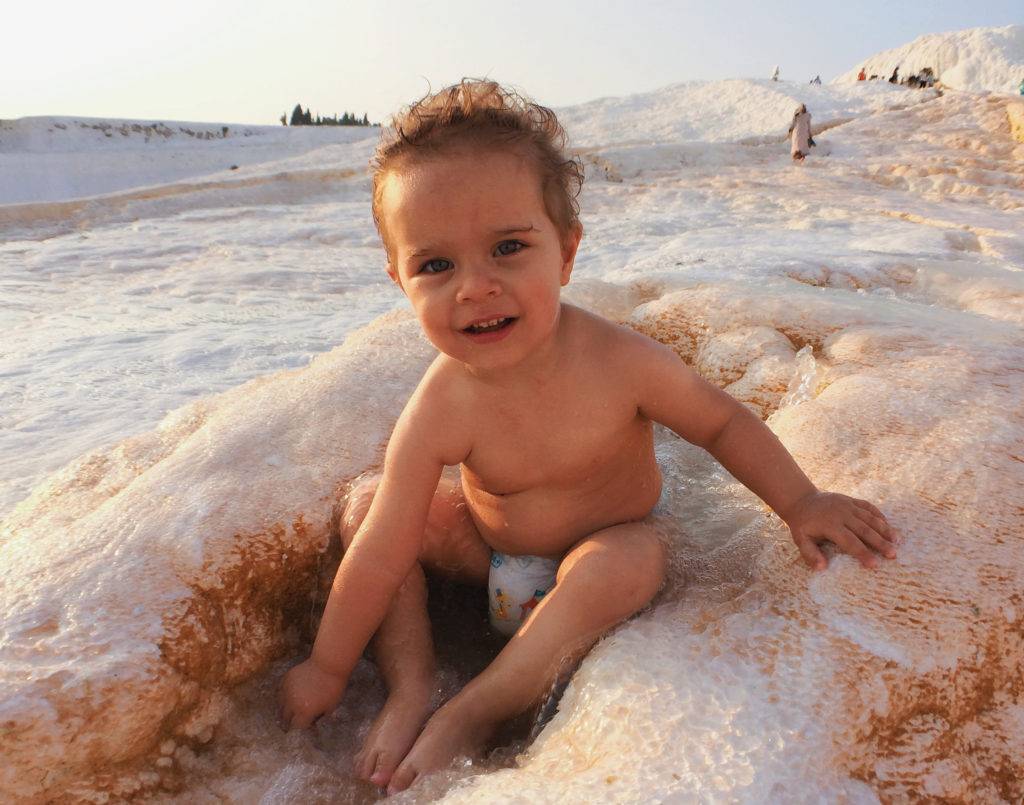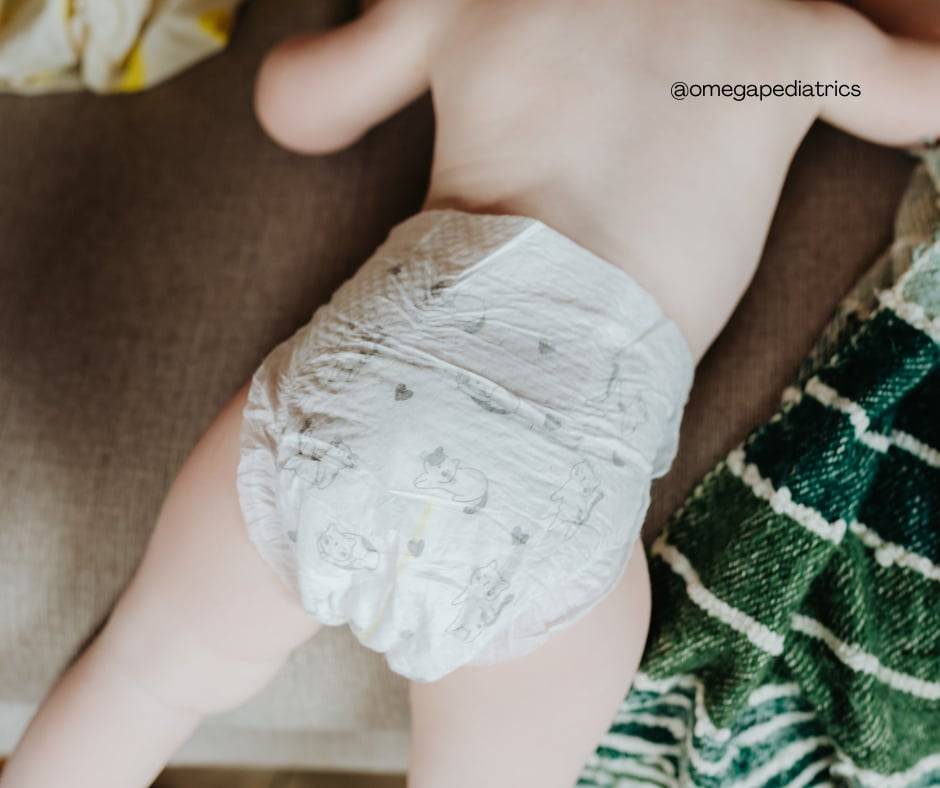Table of Contents

Bathing your newborn can foster a unique connection that strengthens the bond between parent and child. However, it poses a challenge to inexperienced parents, considering the baby’s fragility and unfamiliarity with water.
To ensure the safety of your little one while bathing, it’s essential to learn the proper techniques. It’s recommended, though, to delay your baby’s first bath for a few days after delivery for a few good reasons.
Delaying the first bath allows the vernix, a protective waxy layer that envelops the baby’s skin while in the womb, to stay longer due to its hydrating and shielding characteristics, which are beneficial to your baby.
Lastly, delaying the first bath enables the baby to acclimate to their new environment. It also helps them regulate their body temperature.
How to Bathe Your Newborn
1. Choose the Right Time
The right timing can make a difference. Pick a time when your baby is awake and alert but not hungry or tired. For most babies, this means a bath in the morning or early afternoon.
2. Gather Your Supplies
Ensure you have all the necessary supplies readily available. These are:
- A baby bathtub or a sink with a towel or foam pad to cushion the baby.
- Mild, fragrance-free baby soap and shampoo.
- A soft washcloth or sponge.
- A cup or pitcher for rinsing.
- A hooded towel.
- A thermometer3. Prepare the Bathtub
Fill the bathtub with warm water. The level should cover your baby’s entire body before bathing them. With a thermometer, check the water’s temperature and maintain it between 90 and 100 degrees Fahrenheit for comfort.
Make it a habit before immersing your baby in the water. Ensure the warmth is suitable by checking it with your elbow or wrist.
4. Undress Your Baby and Bathtime
Remove your baby’s clothes and diapers when it’s time to begin bathing. If, for some reason, you can’t begin bathing but have already undressed your baby, it would be best to wrap them in a towel to keep them warm.
- Support Your Baby
Hold your baby with one hand, and use your other hand to gently support the head and neck. Slowly lower them into the water, feet first. Use your free hand to scoop water over their bodies. The head should always be above the water level.
- Clean Your Baby
Adequately clean every part of your baby’s delicate skin. Use mild, fragrance-free soap specially formulated for infants, and a gentle washcloth or sponge. Pay attention to the creases and folds of the skin, such as behind the ears, underneath the arms, and the diaper region.
Be cautious while using a cup or pitcher for rinsing. Wipe the head and face with warm running water, but never immerse them in water.
- Dry Your Baby
Carefully lift your baby out of the water and wrap them in a hooded towel. Ensure to completely dry every skin surface. Handle with care while grooming your baby; use a brush or comb with soft bristles only.
- Moisturize
Apply a mild moisturizer to help keep delicate skin soft and supple after giving your baby a bath. Opt for a baby-specific product that is free of fragrance and hypoallergenic.

Tips for a Safe and Enjoyable Bathing
Bath time is an enjoyable moment with your baby. However, accidents and unwanted mishaps can happen to you and your child. Here are a few tips and reminders:
- Never leave the baby alone in the tub when bathing. In case you need to tend to something else, carry your baby with you.
- Babies are fragile. Maintain a secure hold on your baby throughout the bathing process, supporting their neck and head with one hand.
- Check the water temperature before placing your baby in the tub. Babies have delicate skin that can easily be burned by hot water.
- Position the baby bathtub on a stable, secure, and flat surface. You can place it on the shower floor or on a table, whichever is more convenient for you to bathe your baby.
- Don’t position the baby tub, with your baby in it, directly under the faucet.
- Conversely, be watchful of the floor you’re standing on while bathing your baby. Be cautious when bathing your baby in the bathroom over tiled flooring, as accidental slippage may happen.
- Avoid getting soap or water in your baby’s eyes, nose, or mouth. If this happens, rinse the affected area with clean water immediately.
- Don’t use too much soap, too much lather will do more harm than good.
- Use tear-free shampoo. There are many baby shampoos commercially available.
- Clean your baby’s genitals carefully.
- Dress your baby in comfort once they’re clean and dry.
- If your baby seems fussy or uncomfortable during the bath, don’t force it. Exert effort to know the reason for the discomfort. You can also try again at a later time when they’re feeling more relaxed and comfortable.
Bath times are supposed to be enjoyable moments for babies. If your baby cries for discomfort, there should be an underlying reason. If you have any doubts about your baby’s discomfort during bath time, don’t hesitate to consult your baby’s pediatrician.
How Often Should You Bathe Your Newborn?
New parents might feel intimidated by the thought of bathing their newborn. They may be unsure of how often and how to bathe, newborns don’t require daily baths since their sensitive skin is still adjusting to life outside the womb.

Among newborns, overbathing may lead to the depletion of natural oils in their skin, which can ultimately cause dryness, irritation, and rashes. According to pediatricians, newborns should only be given a bath twice or three times a week.
A sponge bath is typically recommended during the first few weeks until the umbilical cord stump is gone and the circumcision, if applicable, has fully healed. For the baby’s safety during the bath, maintain a warm and draft-free environment and support them properly.
Always maintain cleanliness and dryness on the baby’s face, neck, and diaper region between bath times. Use a warm washcloth and mild, unscented wipes to clean skin folds, like behind their ears and underarms, to avoid rashes and other skin infections.
Babies have unique characteristics that require careful attention, especially during bathing time. It’s important to prioritize their well-being, skin condition, and energy levels. Consult with your child’s pediatrician if you’re unsure about the frequency of bath time.
How to Deal With Bath Time Fears And Anxieties For New Parents
Inexperienced parents may find it challenging to bathe their babies. They might sometimes feel nervous or uncomfortable. However, there are several methods to help parents make their child feel calm and confident during bath time.
- Create a Soothing Atmosphere
To begin, it would be best to establish a soothing atmosphere in the bathroom. It’s recommended to lower the lighting intensity, play soft melodies, and fill the bathtub with warm water. In this way, it makes the bathroom more inviting for your child and creates a playful mood.
- Make a Bathtime Routine
Parents will devise a bath time routine so that the child gets familiar with what to expect and what they should do every time they take a bath. This setup makes the child feel more empowered during the process.
- Use Positive Reinforcement.
Parents can use positive reinforcement to encourage their child’s cooperation and confidence during bath time. This may involve giving your child simple praise, gestures, and appreciation, even for small achievements.
Express appreciation when your child achieves small things, such as putting their face in the water or splashing their feet. Toys or favorite activities can be offered as rewards.
- Introduce Toys and Activities
Parents can introduce toys and activities to make bath time more enjoyable for the child. Bath toys, such as rubber ducks or foam letters, provide a distraction and make the experience more engaging. Parents can sing songs or tell stories to keep the child entertained.
- Use Baby-Friendly Supplies
It matters to use shampoos, sponges, and soaps specially designed for babies and toddlers. For shampoos, choose tear-free variants. If not, harsh ingredients can make the baby’s eyes painful, thus instilling fear of bathing in the child due to an unpleasant experience.
For sponges, ensure they are made of soft fiber materials for the baby’s sensitive skin. Otherwise, the hard fibers in sponges can be painful, thus creating a negative attitude among babies towards bathing time.
It may be helpful to consult with a healthcare professional if a child continues to show signs of fear or anxiety during bath time. Pediatricians or child psychologists can provide guidance on this subject.

The Importance of Skin-to-Skin Contact During Bath Time
Babies need physical contact with their parents while being exposed to water during bath time. Research has shown that infants greatly benefit from skin-to-skin contact during bath time.
- It’s part of infant development. Having the baby rest on the parent’s chest while bathing creates a sense of warmth, safety, and comfort for both the parent and the baby.
- The connection helps regulate the babies’ bodily functions such as temperature, heart rate, and breathing, providing a solid foundation for their well-being.
- The touching experience promotes emotional connection and strengthens attachment in a positive way.
- Physical contact can lower stress levels and have other health advantages that have long-term effects on infants’ overall health.
- Enhances breastfeeding success. It stimulates the release of hormones that promote lactation and helps infants latch on more easily, leading to improved milk production and a positive breastfeeding experience for both the parent and the baby.
Make Baby’s Bath Time Happy Moments
Parents who lack experience may find bathing their babies a daunting task. However, bathing can be a valuable opportunity to establish a connection with your child while maintaining hygiene. Follow the simple yet effective tips presented to ensure a pleasant bathing experience.
Ensure that you select a suitable time, gather all the needed supplies, offer physical assistance to your child, cleanse them with baby-friendly products, and ultimately moisturize their gentle skin following their bath.
With a little practice and patience, you’ll soon become a pro at bathing your new baby and enjoy this special time together.
If at any instance you’re unsure of bathing your baby, or your baby expresses any discomfort while bathing, don’t hesitate to book an appointment with us. We at Omega Pediatrics will be glad to welcome you to our office to help you with the problem.
FAQ
Why is it Recommended to Delay a Newborn’s First Bath?
Delaying the first bath allows the protective vernix to stay longer on the baby’s skin, providing hydration and shielding benefits. It also helps the baby acclimate to their new environment and regulate body temperature.
How Can I Ensure a Safe and Comfortable Bath for My Newborn?
Choose a suitable time when your baby is awake and alert but not hungry or tired. Gather all necessary supplies beforehand and maintain the water temperature between 90 and 100 degrees Fahrenheit. Support your baby securely throughout the bath and be cautious of potential hazards.
How Often Should I Bathe My Newborn?
Newborns typically don’t require daily baths as their sensitive skin adjusts to life outside the womb. Pediatricians recommend bathing them only two or three times a week, especially during the first few weeks until the umbilical cord stump is gone and circumcision, if applicable, has fully healed.
How Can I Help My Baby Overcome Bath Time Fears and Anxieties?
Establish a soothing atmosphere in the bathroom, create a consistent bath time routine, use positive reinforcement, introduce toys and activities, and ensure you’re using baby-friendly supplies. Skin-to-skin contact during bath time also promotes emotional connection and strengthens attachment.
What Should I Do if I’m Unsure About Bathing My Baby or if My Baby Shows Discomfort During Bath Time?
If you’re unsure about bathing your baby or if your baby expresses discomfort during bath time, don’t hesitate to seek guidance from healthcare professionals. Pediatricians or child psychologists can offer advice and support to ensure a positive bathing experience for both you and your baby.



